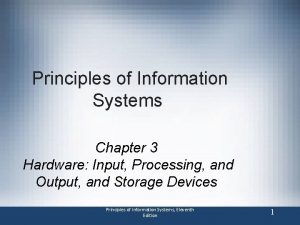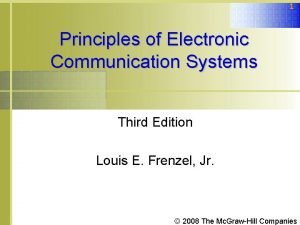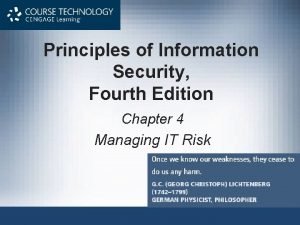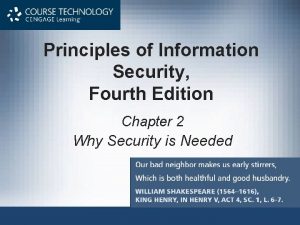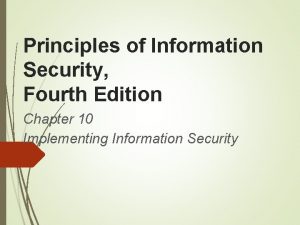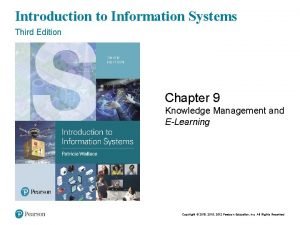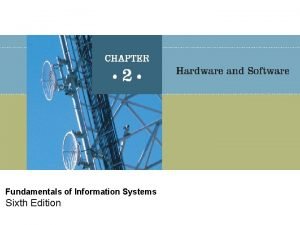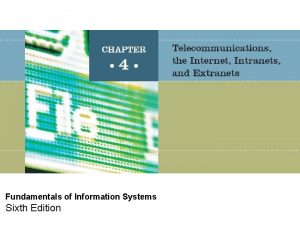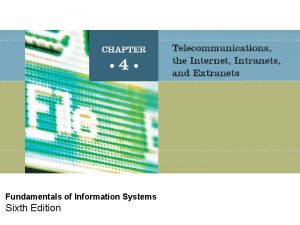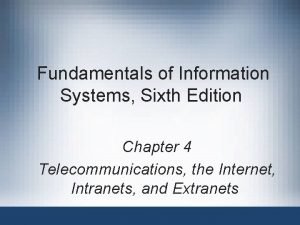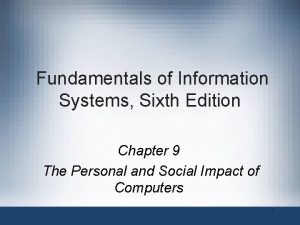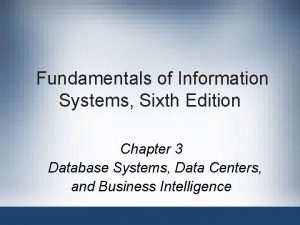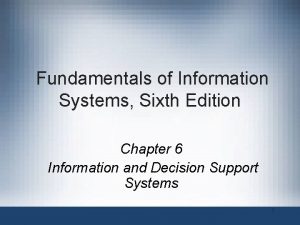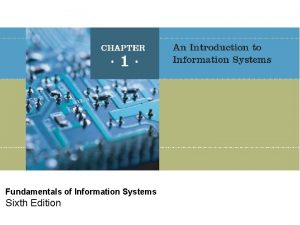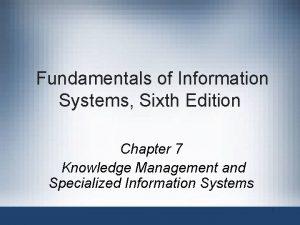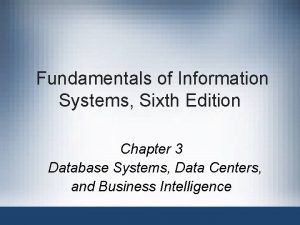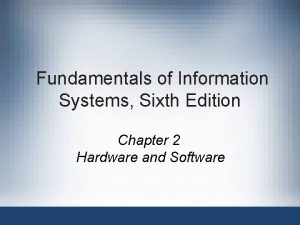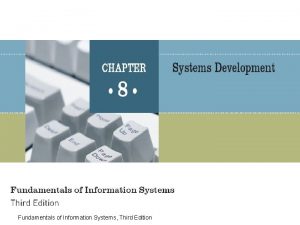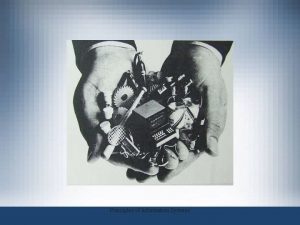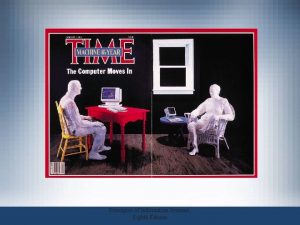Fundamentals of Information Systems Sixth Edition Principles and




























- Slides: 28

Fundamentals of Information Systems Sixth Edition

Principles and Learning Objectives • E-commerce is a new way of conducting business, and as with any other new application of technology, it presents both opportunities for improvement and potential problems. – Identify several advantages of e-commerce. – Identify some of the major challenges that companies must overcome to succeed in e-commerce and mcommerce. – Describe some of the current uses and potential benefits of m-commerce. – Identify several e-commerce applications. Principles of Information Systems, Sixth Edition. 2

Principles and Learning Objectives (continued) • E-commerce requires the careful planning and integration of a number of technology infrastructure components. – Outline the key components of technology infrastructure that must be in place for e-commerce to succeed. – Discuss the key features of the electronic payment systems needed to support e-commerce. Principles of Information Systems, Sixth Edition. 3

Principles and Learning Objectives (continued) • An organization’s transaction processing system (TPS) must support the routine, day-to-day activities that occur in the normal course of business and help a company add value to its products and services. – Identify the basic activities and business objectives common to all TPSs. – Explain some key control and management issues associated with TPSs. – Identify the challenges multinational corporations must face in planning, building, and operating their TPSs. Principles of Information Systems, Sixth Edition. 4

Principles and Learning Objectives (continued) • Implementation of an enterprise resource planning (ERP) system enables a company to achieve many benefits by creating a highly integrated set of systems. – Discuss the advantages and disadvantages associated with the implementation of an ERP system. Principles of Information Systems, Sixth Edition. 5

5. 1 E-Commerce and Mobile Commerce: • E-Commerce: any business transaction executed electronically between parties such as: • Business-to-consumer (B 2 C) e-commerce: customers deal directly with the organization, avoiding any intermediaries. • Business-to-business (B 2 B) e-commerce: participants are organizations. • Consumer-to-consumer (C 2 C) e-commerce: participants are individuals, with one serving as the buyer and the other, the seller. Principles of Information Systems, Sixth Edition. 6

The E-Commerce Supply Chain • Supply chain management is a key value chain composed of: – Demand planning. – Supply planning. – Demand fulfillment. • E-commerce supply chain management allows businesses an opportunity to achieve: – Increased revenues and decreased costs. – Improved customer satisfaction. – Inventory reduction across the supply chain. Principles of Information Systems, Sixth Edition. 7

Figure 5. 1: Supply Chain Management Principles of Information Systems, Sixth Edition. 8

Mobile Commerce • Mobile commerce (m-commerce) relies on the use of wireless devices, such as personal digital assistants, cell phones, and smart phones, to place orders and conduct business. • Issues confronting m-commerce: – User-friendliness of the wireless device. – Network speed. – Security. • Wireless application protocol (WAP): a standard set of specifications for Internet applications that run on handheld, wireless devices Principles of Information Systems, Sixth Edition. 9

5. 2 E-Commerce Applications: Retail and Wholesale • Electronic retailing (e-tailing): the direct sale from business to consumer through electronic storefronts, typically designed around an electronic catalog and shopping cart model • Cybermall: a single Web site that offers many products and services at one Internet location • Manufacturing, repair, and operations (MRO) goods and services. Principles of Information Systems, Sixth Edition. 10

Manufacturing • To raise profitability and improve customer service, many manufacturers move their supply chain operations onto the Internet. • Electronic exchange: an electronic forum where manufacturers, suppliers, and competitors buy and sell goods, trade market information, and run backoffice operations. Principles of Information Systems, Sixth Edition. 11

Marketing • Market segmentation: the identification of specific markets to target them with advertising messages. • Technology-enabled relationship management: use of detailed information about a customer’s behavior, preferences, needs, and buying patterns to set prices, negotiate terms, tailor promotions, add product features, and otherwise customize the entire relationship with that customer. Principles of Information Systems, Sixth Edition. 12

Investment and Finance • Online stock trading – Portfolio tracker • Online banking – Electronic bill presentment Principles of Information Systems, Sixth Edition. 13

Software • Security and identification. • Retrieving and sending Web pages. • Web page construction– Static Web page. – Dynamic Web page. • E-commerce software must support: – Catalog management. – Product configuration. – Shopping-cart facilities. Principles of Information Systems, Sixth Edition. 14

5. 3 Electronic Payment Systems • Digital certificate: an attachment to an e-mail message or data embedded in a Web page that verifies the identity of a sender or a Web site. • Electronic cash: an amount of money that is computerized, stored, and used as cash for e-commerce transactions. • Electronic wallet: a computerized stored value that holds credit card information, electronic cash, owner identification, and address information: • Credit card • Charge card • Debit card • Smart card Principles of Information Systems, Sixth Edition. 15

5. 4 Traditional Transaction Processing Methods and Objectives • Batch processing system: method of computerized processing in which business transactions are accumulated over a period of time and prepared for processing as a single unit or batch • Online transaction processing (OLTP): computerized processing in which each transaction is processed immediately, without the delay of accumulating transactions into a batch. Principles of Information Systems, Sixth Edition. 16

Figure 5. 2: Batch Versus Online Transaction Processing Principles of Information Systems, Sixth Edition. 17

Transaction Processing System • Transaction Processing System (TPS): An organized collection of people, procedures, software, databases and devices used to record completed business transactions. Principles of Information Systems, Sixth Edition. 18

Transaction Processing Activities • Data collection– Should be collected at source. – Should be recorded accurately, in a timely fashion. • • • Data editing. Data correction. Data manipulation Data storage Document production and reports Principles of Information Systems, Sixth Edition. 19

5. 5 International Issues • Issues that multinational corporations face in planning, building, and operating their TPSs: – – Different languages and cultures. Disparities in IS infrastructure. Varying laws and customs rules. Multiple currencies. Principles of Information Systems, Sixth Edition. 20

5. 6 Advantages and Disadvantages of ERP Enterprise Resource Planning: Enterprise resource planning (ERP) systems are used in large, midsized, and small companies. • Real-time monitoring of business functions. • Timely analysis of key issues, such as quality, availability, customer satisfaction, performance, and profitability. Principles of Information Systems, Sixth Edition. 21

Advantages and Disadvantages of ERP: • Elimination of costly, inflexible legacy systems. • Improvement of work processes. • Increase in access to data for operational decision making. • Upgrade of technology infrastructure. • Expense and time in implementation. • Difficulty implementing change. • Difficulty integrating with other systems. • Risks in using one vendor. • Risk of implementation failure. Principles of Information Systems, Sixth Edition. 22

5. 7 Types of Information Systems • MIS: A management information system (MIS) provides managers with information that supports effective decision making and provides feedback on daily operations. • The use of MISs spans all levels of management. • • • Types of MIS: Financial MIS. Manufacturing MIS. Marketing MIS. Human resource MIS. Accounting MIS. Principles of Information Systems, Sixth Edition. 23

Outputs of a MIS • Scheduled report: produced periodically, or on a schedule. • Key-indicator report: summary of the previous day’s critical activities. • Demand report: developed to give certain information at someone’s request. • Exception report: automatically produced when a situation is unusual or requires management action. • Drill-down report: provides increasingly detailed data about a situation. Principles of Information Systems, Sixth Edition. 24

5. 7 Types of Information Systems • Decision Support Systems (DSS): is an organized collection of people, procedures, software, databases, and devices used to support problem-specific decision making and problem solving. • The focus of a DSS is on decision-making effectiveness when faced with unstructured or semistructured business problems. • Geographic information system (GIS): capable of assembling, storing, manipulating, and displaying geographic information. Principles of Information Systems, Sixth Edition. 25

• Executive support system (ESS): specialized DSS that includes all hardware, software, data, procedures, and people used to assist senior-level executives within the organization. • • Tailored to individual executives. Easy to use. Drill-down capable. Support the need for external data. • Supply Chain Management (SCM): helps determine what supplies are required, what quantities are needed to meet customer demand, how the supplies are to be processed (manufactured) into finished goods and services, and how the shipment of products and services is to be scheduled and monitored to the customers. Principles of Information Systems, Sixth Edition. 26

• Customer Relationship Management (CRM): helps a company manage all aspects of customer encounters, including marketing, advertising, sales and after sale services etc. CRM can also be used to get customer feedback to help design new products and services. • Knowledge Management (KM): • is the process of capturing a company's collective expertise wherever it reside- in computers, on paper, or in people's head- and distributing it wherever it can help produce the biggest payoff. Principles of Information Systems, Sixth Edition. 27

Self Examination Questions Short Answer Questions (3 marks) 1) Name the Transaction Processing activities and the International issues involved. 2) What is ERP? Give some of its advantages. 3) Define the terms: m-commerce, WAP, Cybermall and OLTP. Long Answer Questions (5 marks) 4) Describe the Supply Chain Management. 5) What is an E-Commerce? Elaborate any THREE e-Commerce applications in detail. 6) Explain the Electronic Payment System. 7) Name the types of MIS. Explain the different types of Outputs of MIS. 8) Describe different Types of Information Systems in detail. Principles of Information Systems, Sixth Edition. 28
 Fundamentals of information systems 9th edition
Fundamentals of information systems 9th edition Fundamentals of information systems 9th edition
Fundamentals of information systems 9th edition Fundamentals of information systems 9th edition
Fundamentals of information systems 9th edition Fundamentals of information systems 9th edition
Fundamentals of information systems 9th edition Principles of economics sixth edition
Principles of economics sixth edition Information systems literacy
Information systems literacy Principles of information systems 11th edition
Principles of information systems 11th edition Mmodation
Mmodation Rubber baby buggy bumpers tongue twister lyrics
Rubber baby buggy bumpers tongue twister lyrics Biochemistry sixth edition 2007 w.h. freeman and company
Biochemistry sixth edition 2007 w.h. freeman and company Expert systems: principles and programming, fourth edition
Expert systems: principles and programming, fourth edition Computer architecture a quantitative approach sixth edition
Computer architecture a quantitative approach sixth edition Automotive technology sixth edition
Automotive technology sixth edition Automotive technology sixth edition
Automotive technology sixth edition Apa sixth edition
Apa sixth edition Computer architecture a quantitative approach sixth edition
Computer architecture a quantitative approach sixth edition Precalculus sixth edition
Precalculus sixth edition Computer architecture a quantitative approach sixth edition
Computer architecture a quantitative approach sixth edition Fundamental of information system
Fundamental of information system Fundamentals of information systems chapter 1
Fundamentals of information systems chapter 1 Principles of electronic communication systems 3rd edition
Principles of electronic communication systems 3rd edition Principles of electronic communication systems 3rd edition
Principles of electronic communication systems 3rd edition Principles of information security 5th edition pdf
Principles of information security 5th edition pdf Concentration risk
Concentration risk Principles of information security 4th edition
Principles of information security 4th edition Bull's eye model in information security
Bull's eye model in information security Introduction to information systems 6th edition
Introduction to information systems 6th edition Vertical
Vertical Introduction to information systems 3rd edition
Introduction to information systems 3rd edition






